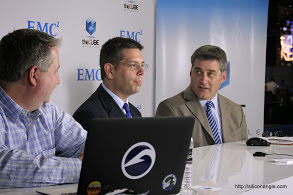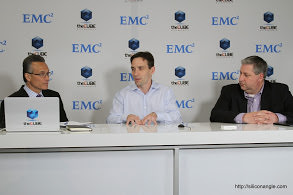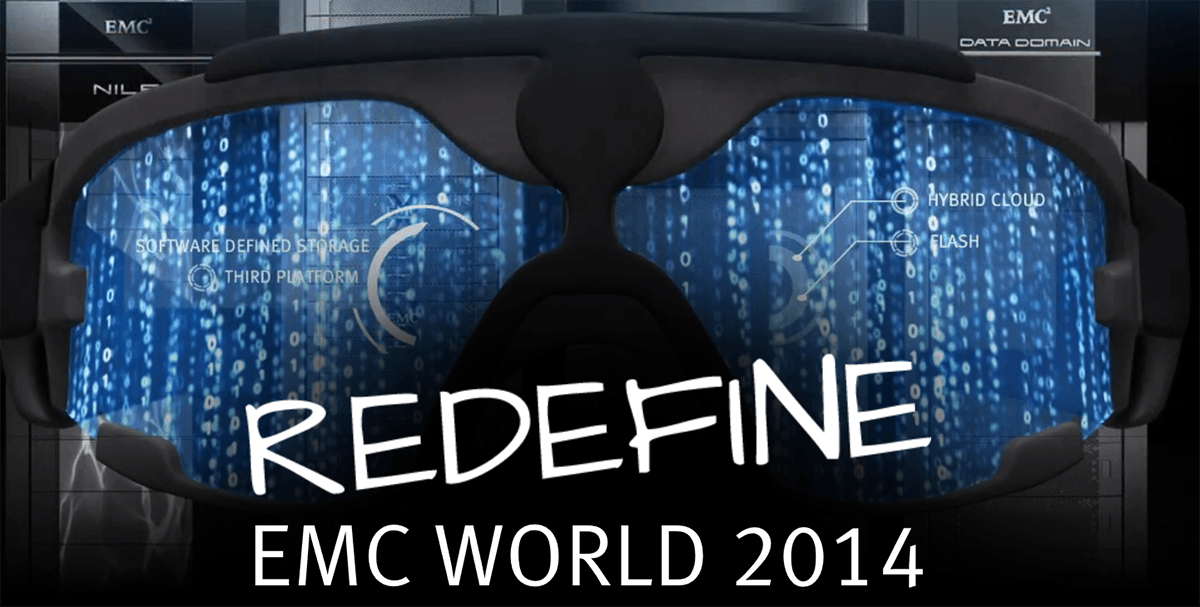So, I only spent two days there but what can you say? Lots of energy went into the making of EMC World 2014. As a technologist I am impressed each year by the level of innovation that that goes into these shows. The outstanding use of video, (e.g. EMC TV, theCube, and all the interviews taking place throughout the show that would be shown later), it is impressive. Combine that with the video, animation and music that went into the key- notes, there was a lot of work done by EMC this year to drive a good deal of energy into the show. There was a great area outside the vendor solutions booths that had a relaxation zone, social lounge, alumni center and a host of other places to work with colleagues.
Why was I there? Couple of reasons:
- Help a company I am working with, VMTurbo, to foster relationships with technology providers and partners that can help drive this exciting new technology deeper into the market place
- To assist SiliconAngle/Wikibon and “theCube” with interviews of EMC Execs as well as my favorite, industry practitioners tell their story about their business, challenges they face and how technology is helping them to achieve their goals and objectives
Now EMC has a number of announcements that take place at EMC World but I will have to say, after doing about 25 interviews with customers and about 10 interviews with EMC Execs, here the my big take aways:
- How much applications are driving infrastructure decisions
• Whether or not to virtualize and application
• Which virtualization technology to use for an application
• Storage decisions around performance - The number of converged infrastructure solutions that are deployed
- The percentage of each data center that is virtualized
- How the new converged trend is allowing people to take advantage of big data trends
- How important cloud is becoming
- The number of vendors providing their solutions to customers via the cloud
- How data protection is evolving to a deeper conversation around data management
Of the end users we spoke to on theCube, 100% of the customers were virtualized and they were all over 55% virtualized, including some of their mission critical applications. Also, it was interesting to note that while 99% of the customers were running VMware, 100% of the customers had 2 or more virtualization strategies in their shop. It is difficult to run 100% of the environment, especially if the environment utilizes a lot of Microsoft applications, on VMware. VMware may not be the right solution for all applications. It is this for this reason that managing a virtualized infrastructure, from a resource standpoint can become difficult and require 3rd party tools. It seems to me that if customers are going to have heterogeneous infrastructure when it comes to virtualization, they would benefit greatly from a tool such as VMTurbo to make sure they are getting the most out of their infrastructure at the right costs. Yuri Rabover is co-founder of VMTurbo was at EMC World because VMTurbo was a vendor in EMC’s New Innovators booth and spoke on theCube as to how they help clients maximize their virtual infrastructures.
I was amazed that over 85% of the folks we talked to also said that they were running on some converged platform whether it be vBlock, VCE or some variation, such as UCS with EMC storage (given that this is an EMC show, no surprise on most of the solutions deployed). That said, they all touted the ease in which they could manage a converged system and stand up VM’s easily as the main reason they were using these platforms, further promoting the reason behind these systems in the first place. People don’t want to be in the management business, they want to be in the doing business business.

Jeff Frick (my co-host on theCube) and I had an interesting conversations was with Jim Hutchins CTO of T2 Systems. We spoke on theCube about a new kind of PaaS – Parking as a Service. What was interesting about this was that first off, from a technology side, they are the 1% that was not virtualized on VMware but 100% on Hyper-V as they do run a lot of Microsoft Apps. Additionally, they are running on a converged, vBlock architecture. T2 Systems runs parking for a number of colleges thought out the US. Here is what is interesting. They are starting to take advantage of “Big Data” (which when I asked, “What keeps you up at night?” and “What is your next big project?” it was big data). You may think what does “Big Data” have to do with parking? A couple of things really. The reality is that campus police don’t like spending their time giving out tickets, so if they can spot a trend in the data, such as an inordinate number of tickets are given out in the fall versus the winter for a particular spot, they may go check that spot to see why. Low and behold, the “No Parking” sign is behind a tree and in the fall, there are leaves on the tree and people can't see the sign, however in the winter the sign is very visible because there are no leaves. We also learned that if students aren’t paying parking tickets, they are spending more money on campus on food, beer and college attire, all which bring in more revenue to the school. T2 also has an app now that can tell you when time is running out in your parking space. Amazing how technology and big data are changing PaaS or Parking as a Service.

It was also interesting to hear how a number of our guests, T2 Systems again for example, are companies that used to have applications where their customers are driving them to the cloud and want them to deliver their application as a cloud service. We also talked to Presidio who is a solutions provider helping customers to implement cloud but also have built their own cloud to help customers who want an off premise solution.

And finally, Dave Vellante and I had a great Interview on theCube w/ Stephen Manley, CTO, DPAD Division at EMC where he was talking about the evolution of data protection. In the past data protection was just a simple repository of data where people go to restore data from, now people want to be able to move data protection closer to the application such that they can leverage this data, have insight to this data and ensure they are protecting it the proper way.
One other interesting take away I would say would be from Joe Tucci’s key note speech. During the opener, EMC announced that they had acquired the company DSSD. Okay, this is only somewhat interesting. Every big vendor in the storage space has or has acquired Flash/SSD technology, why would EMC need yet another SSD technology? But that isn’t the interesting part. During the announcement Joe brought Andy Bechtolsheim, co-founder of Sun Microsystems up on stage. Andy was a key investor in the DSSD technology, yet EMC doesn’t “get” Andy with this acquisition. Andy is hard at work on his own startup called Arista Networks. This begs the question is EMC getting closer to Arista vs Cisco? I mean, why would they do this, seems very odd. A colleague of mine who is a financial analyst and who was in EMC’s financial meetings said that Joe had said that it didn’t mean anything and that Cisco is still their go to key go to market partner. They why bring Andy on stage? Bizarre.
Having worked at EMC it was interesting to see see how far they have come, it was great to see some old friends and overall I was impressed with EMC World 2014 and look forward to seeing how EMC executes over the next 12 months.
